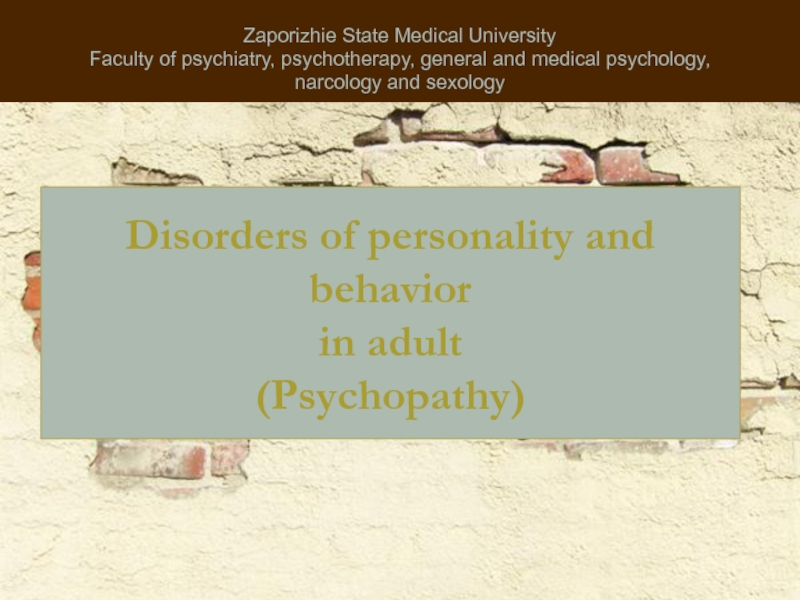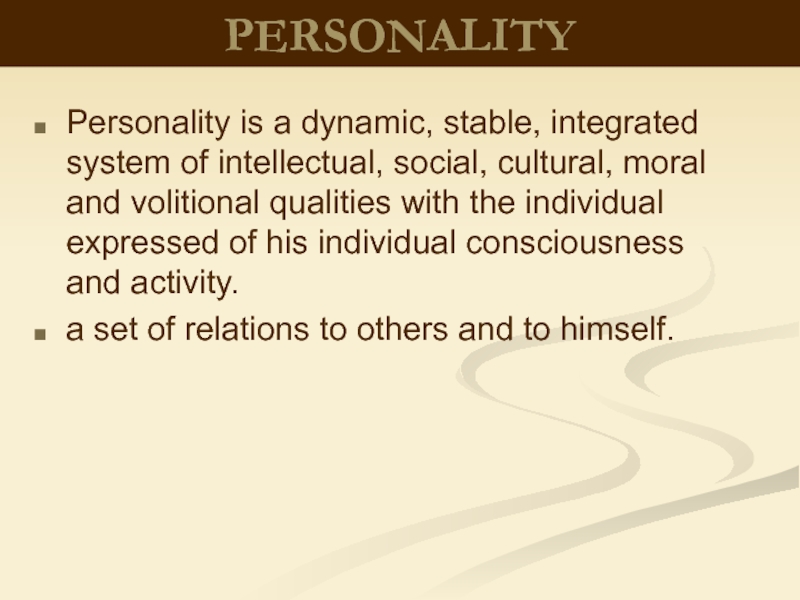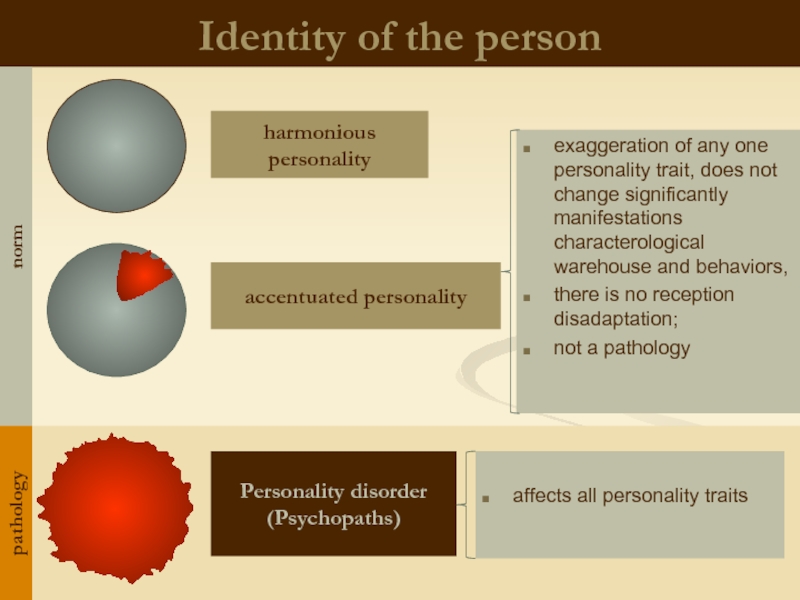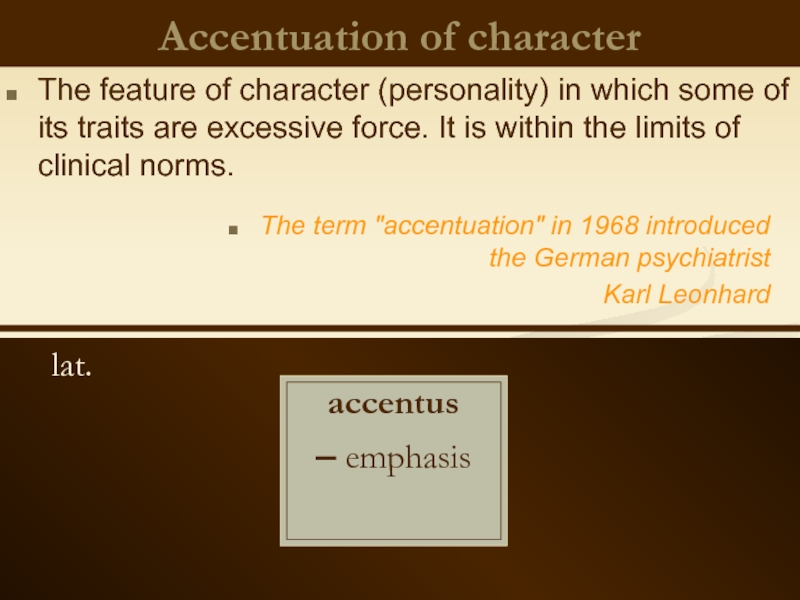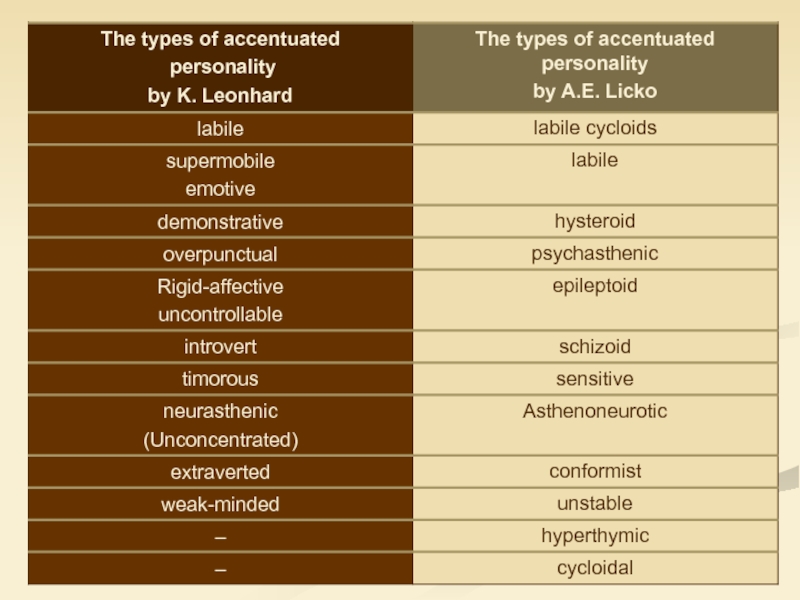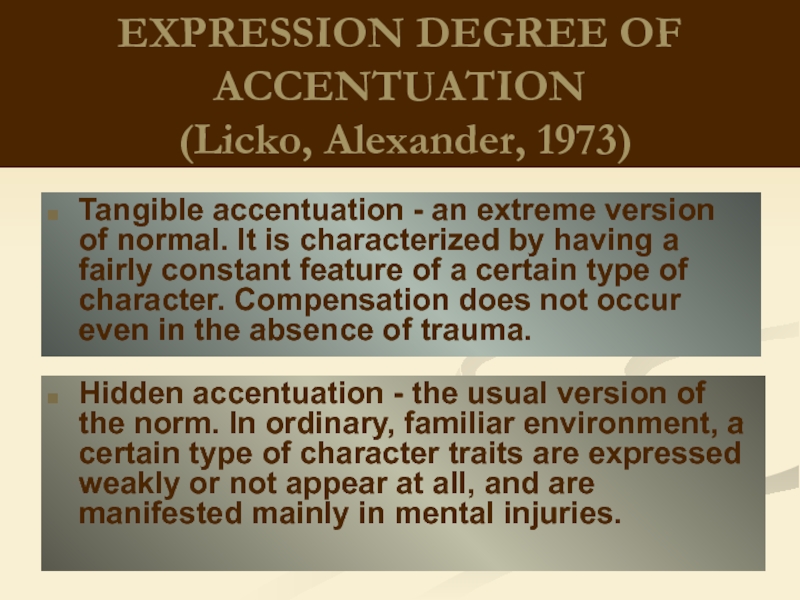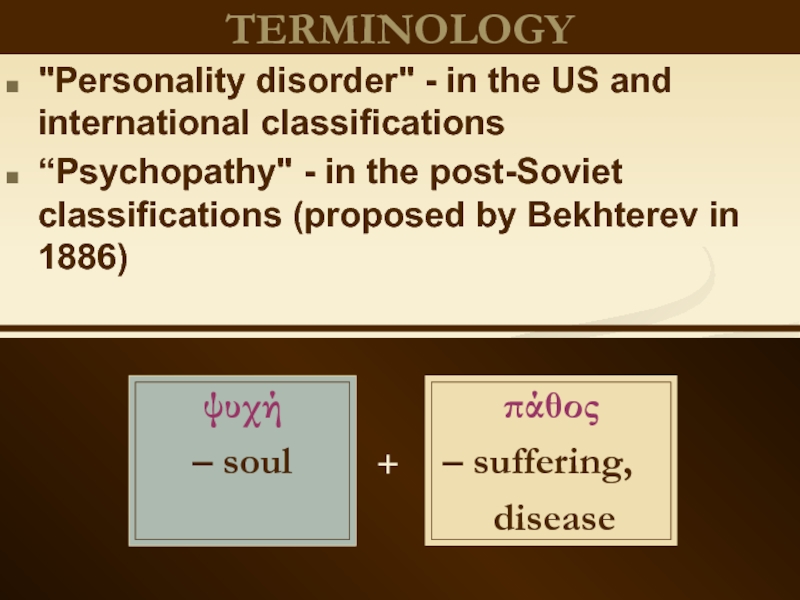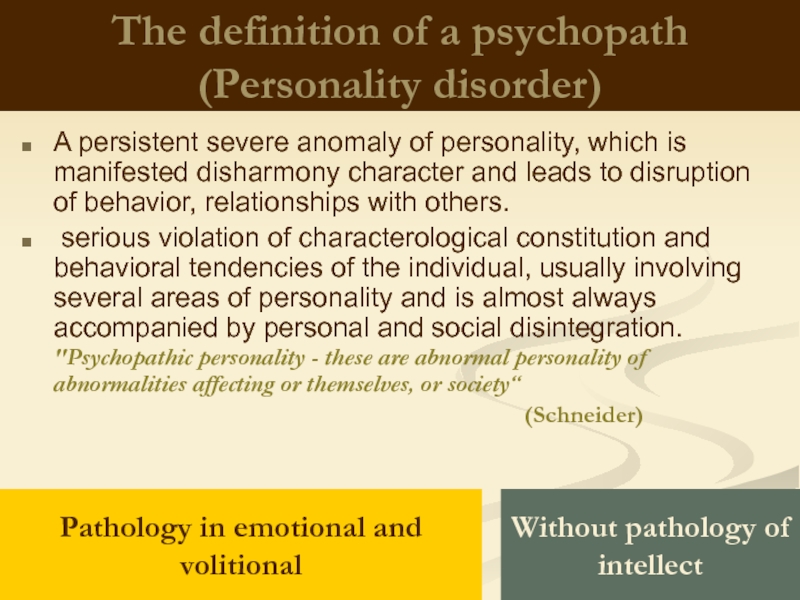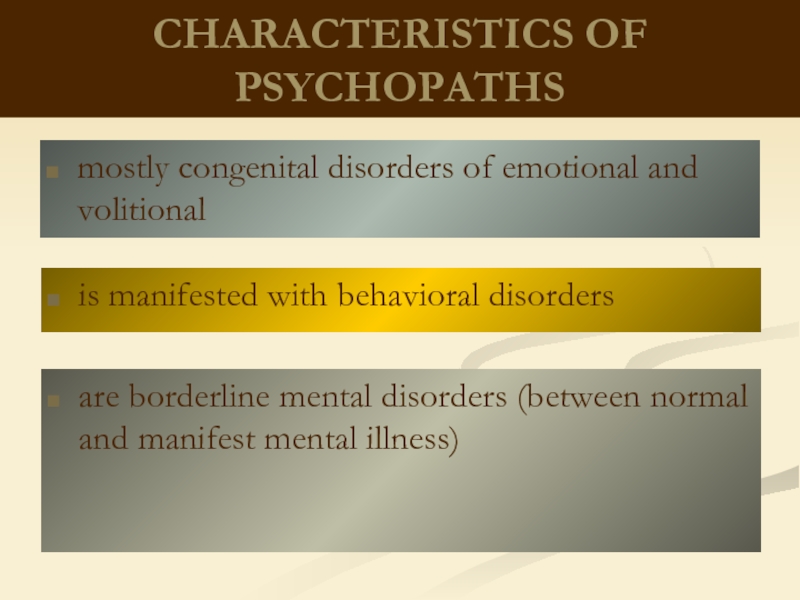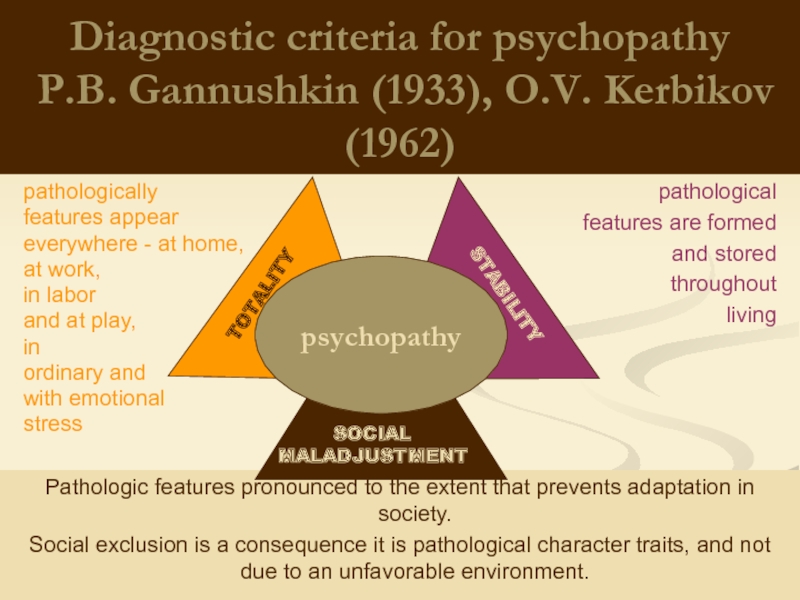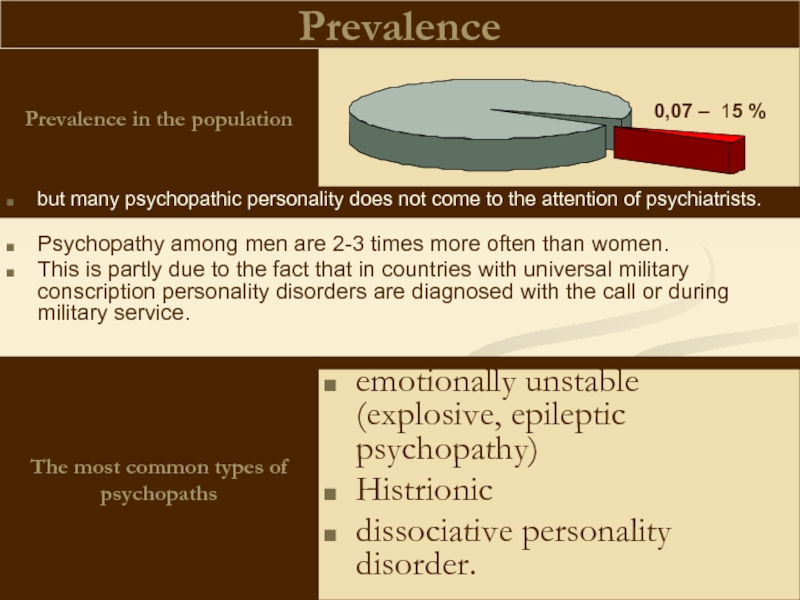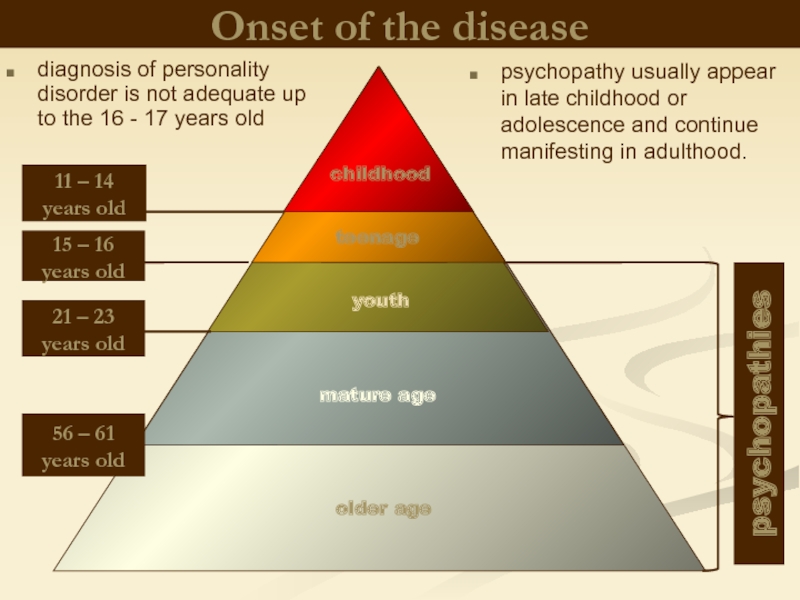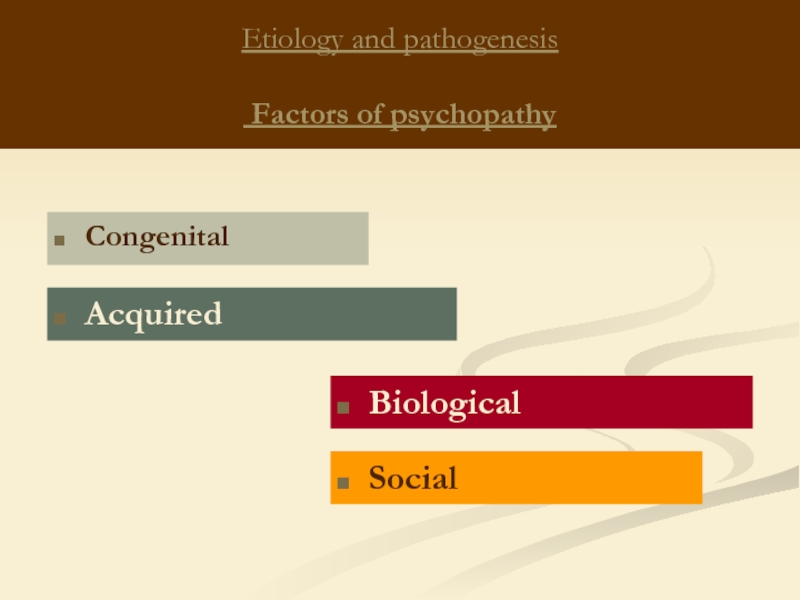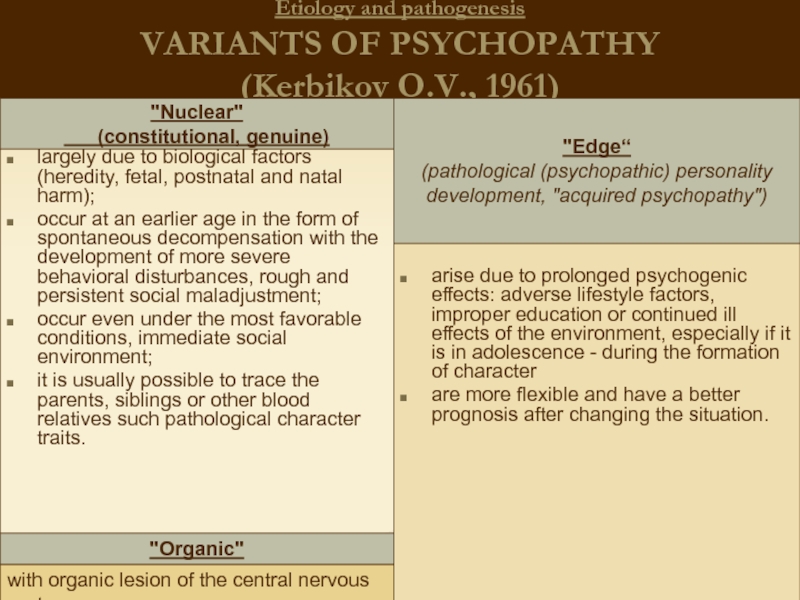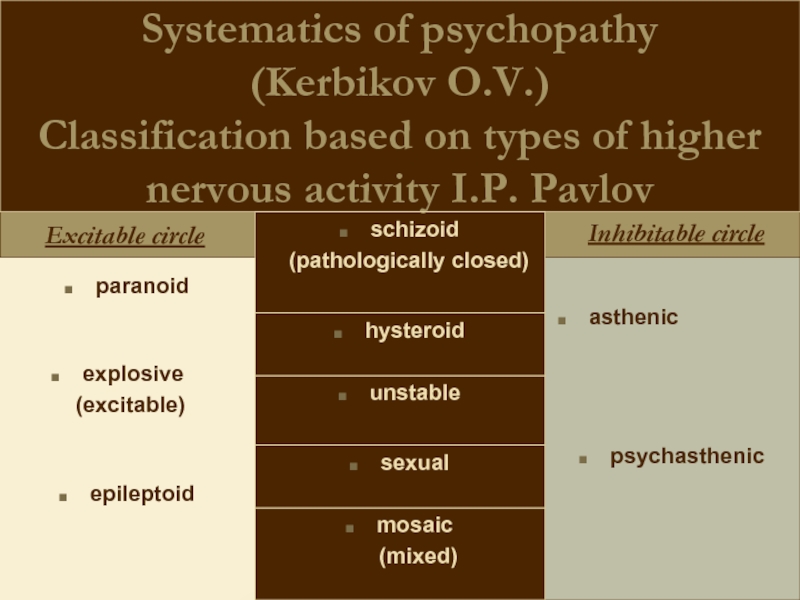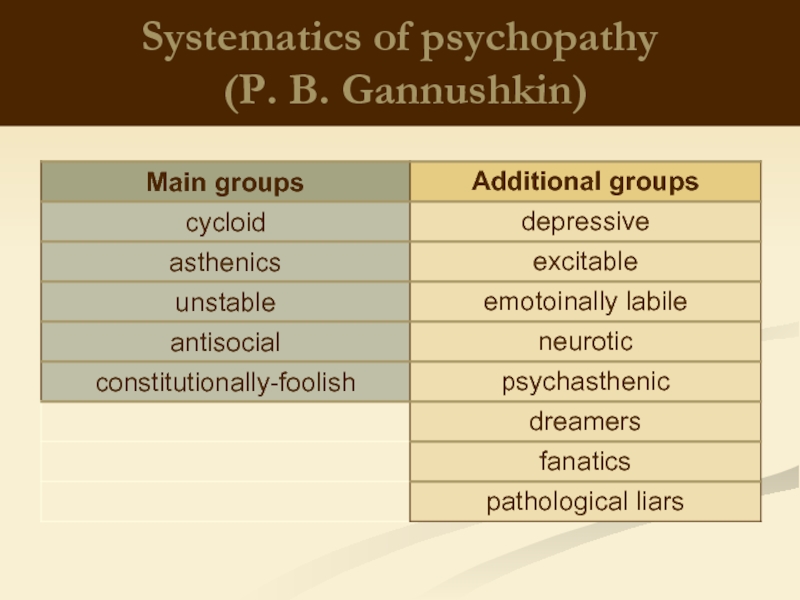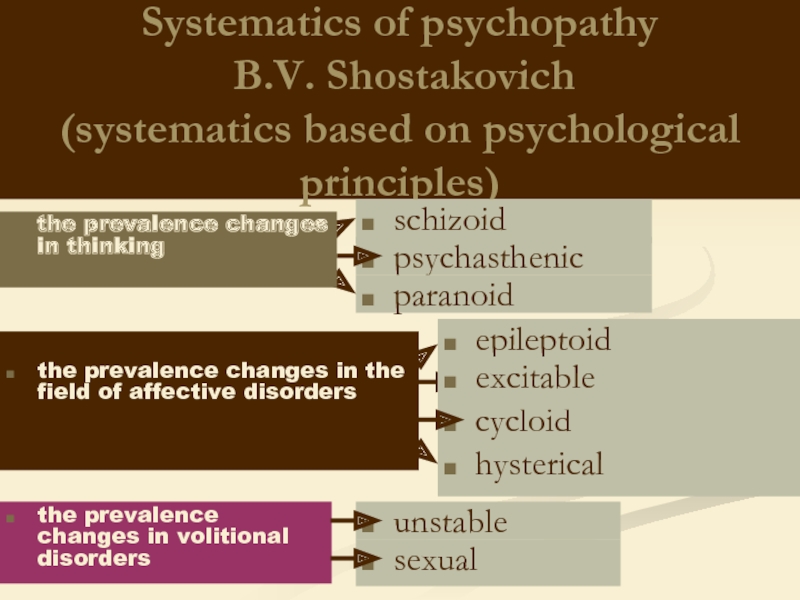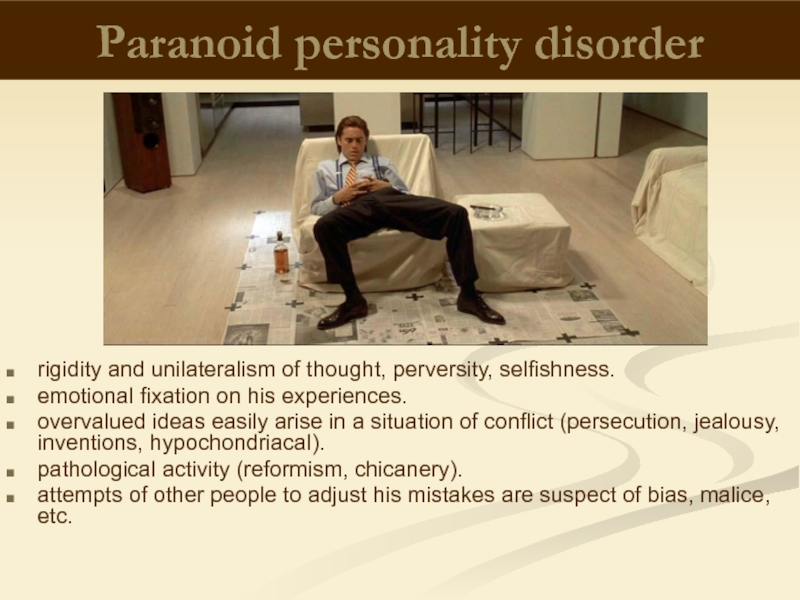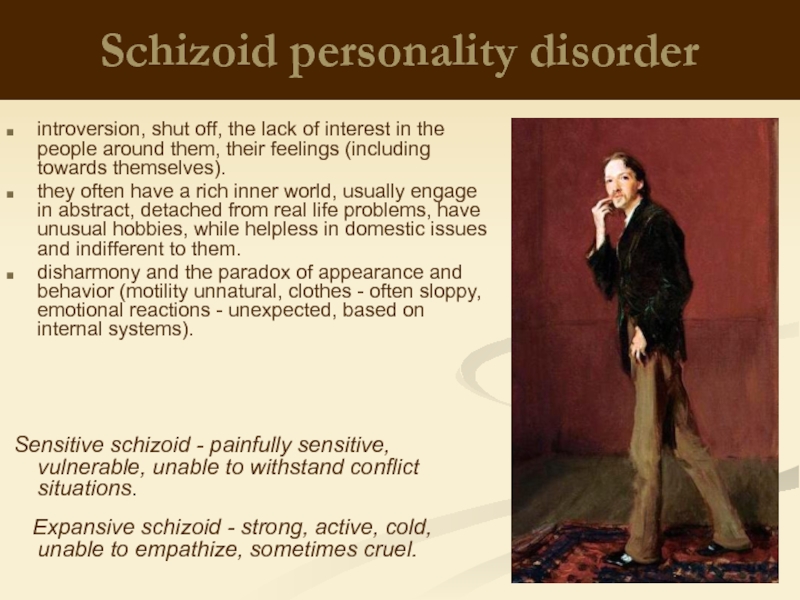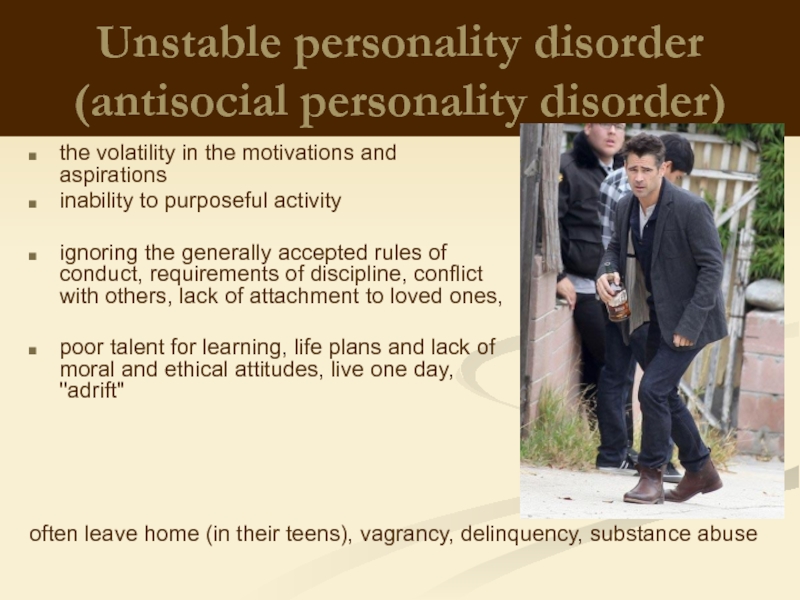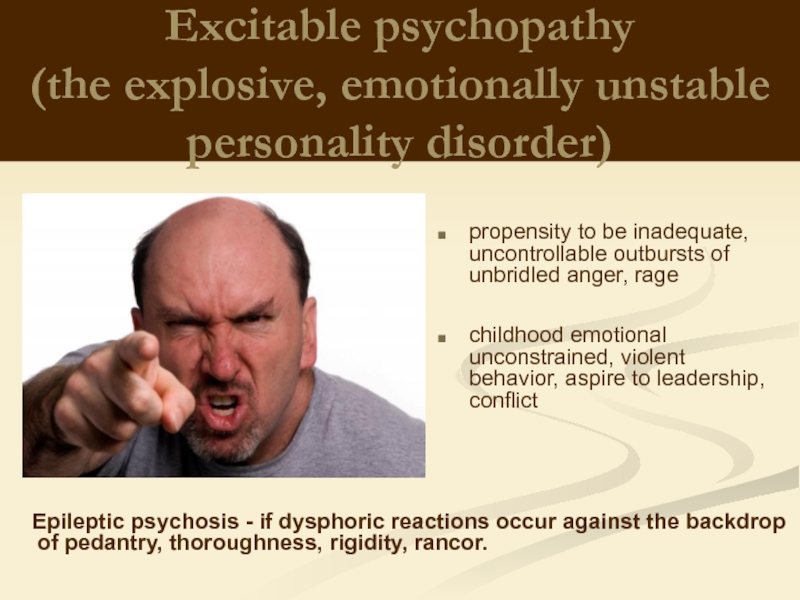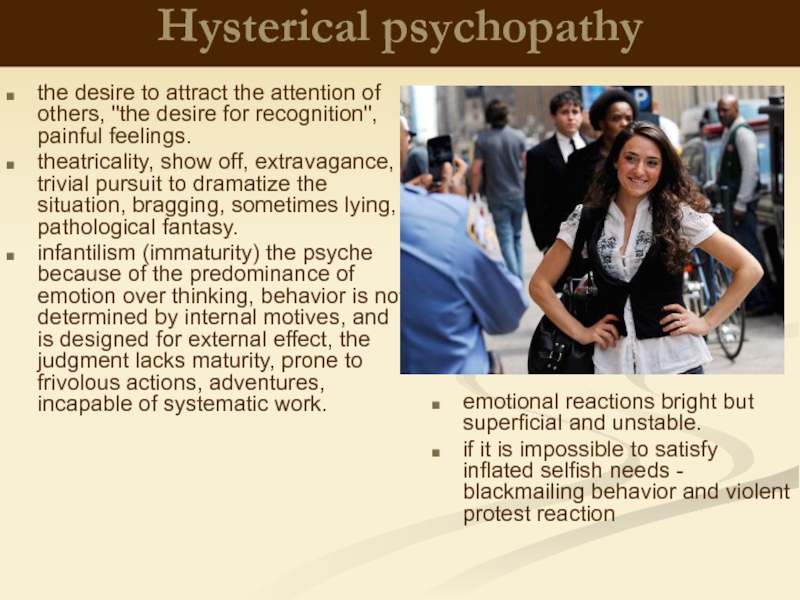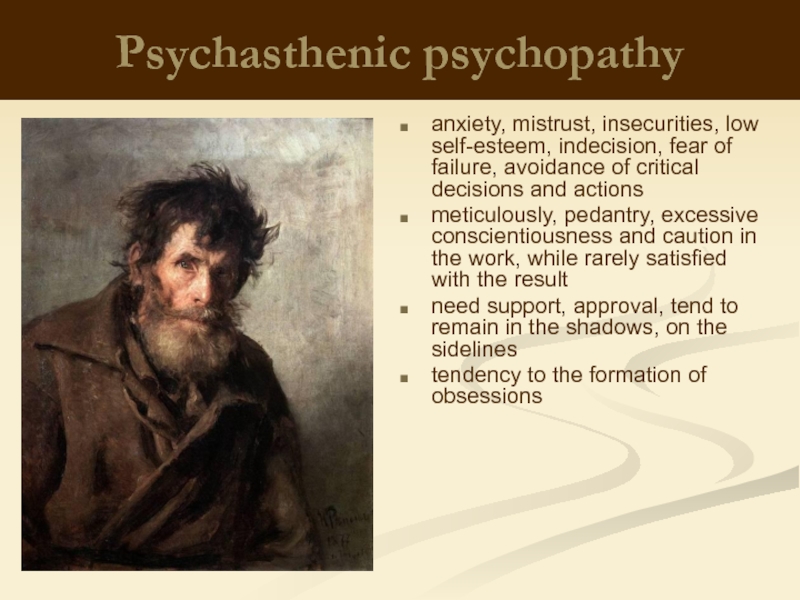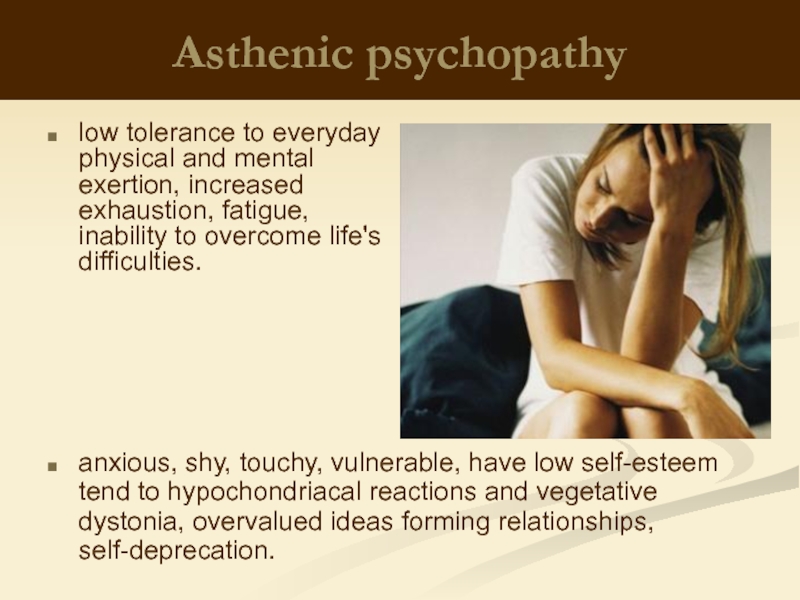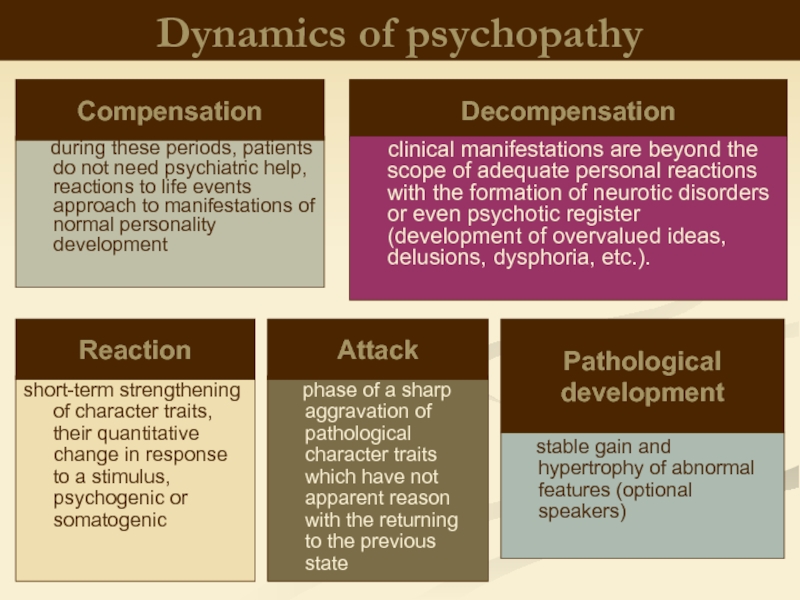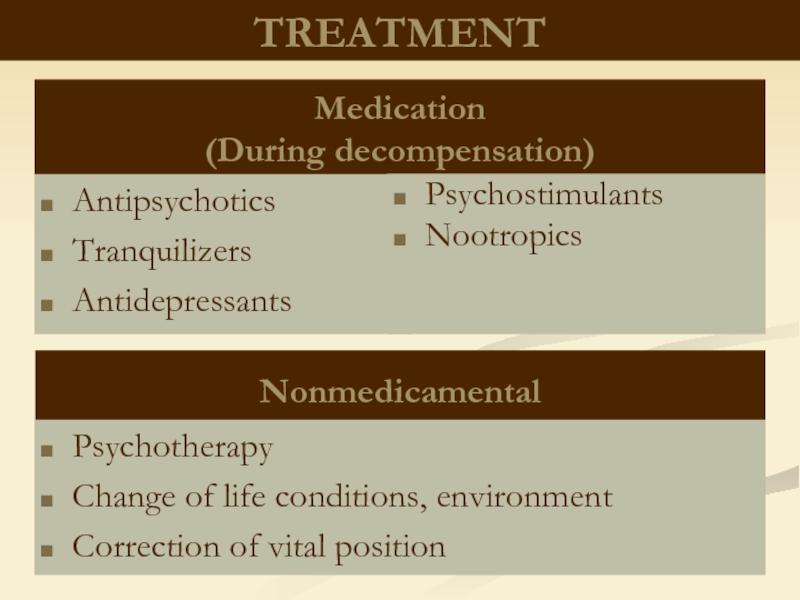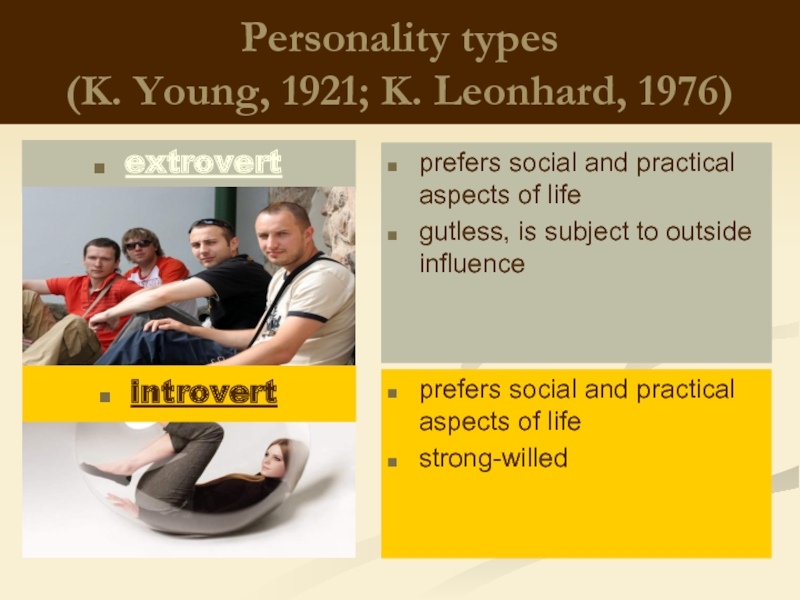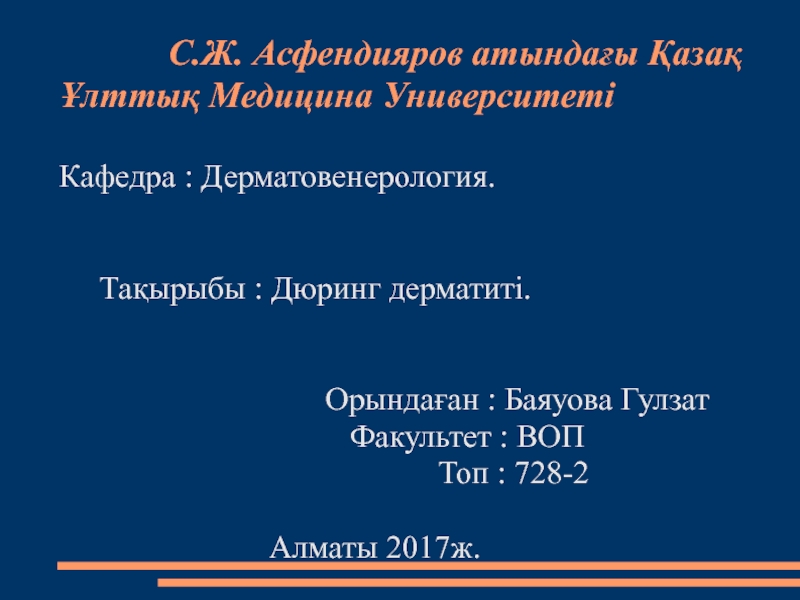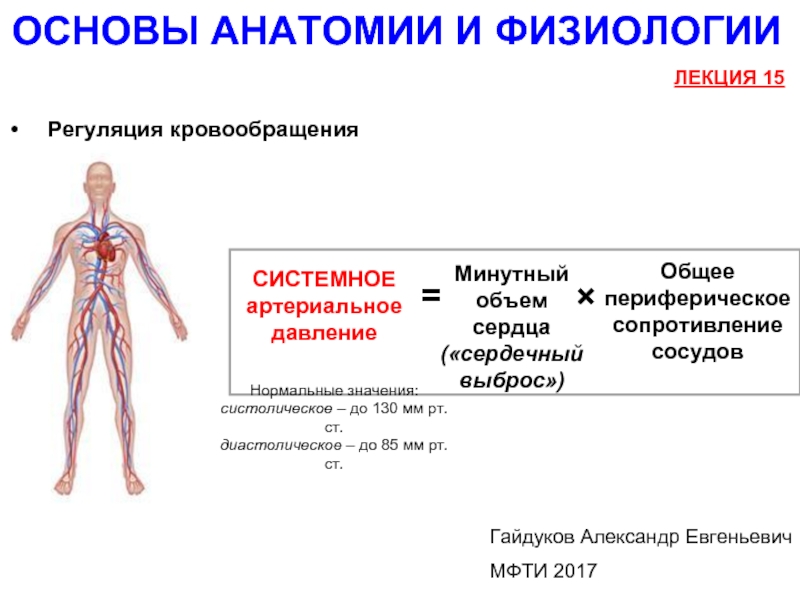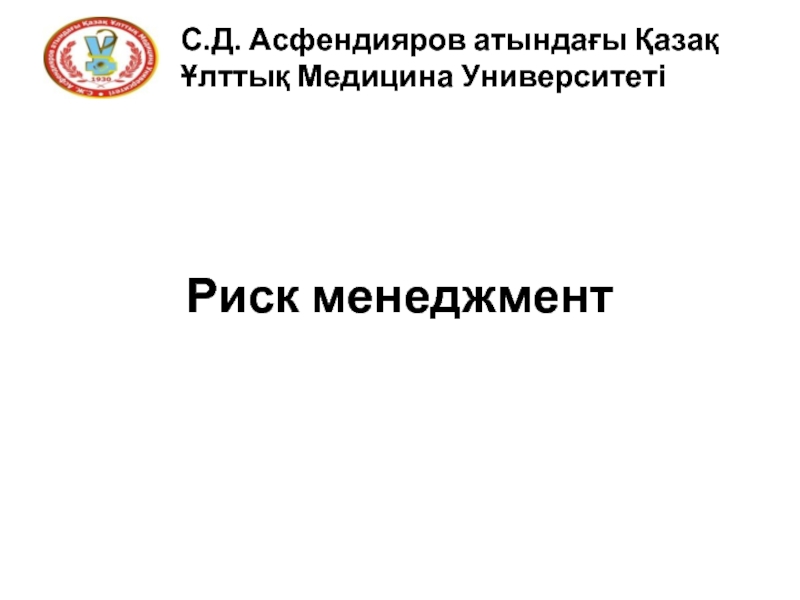- Главная
- Разное
- Дизайн
- Бизнес и предпринимательство
- Аналитика
- Образование
- Развлечения
- Красота и здоровье
- Финансы
- Государство
- Путешествия
- Спорт
- Недвижимость
- Армия
- Графика
- Культурология
- Еда и кулинария
- Лингвистика
- Английский язык
- Астрономия
- Алгебра
- Биология
- География
- Детские презентации
- Информатика
- История
- Литература
- Маркетинг
- Математика
- Медицина
- Менеджмент
- Музыка
- МХК
- Немецкий язык
- ОБЖ
- Обществознание
- Окружающий мир
- Педагогика
- Русский язык
- Технология
- Физика
- Философия
- Химия
- Шаблоны, картинки для презентаций
- Экология
- Экономика
- Юриспруденция
Disorders of personality and behavior in adult (psychopathy) презентация
Содержание
- 1. Disorders of personality and behavior in adult (psychopathy)
- 2. PERSONALITY Personality is a dynamic, stable, integrated
- 3. Identity of the person exaggeration of
- 4. Accentuation of character lat.
- 6. EXPRESSION DEGREE OF ACCENTUATION (Licko, Alexander,
- 7. TERMINOLOGY "Personality disorder"
- 8. The definition of a psychopath (Personality disorder)
- 9. CHARACTERISTICS OF PSYCHOPATHS mostly congenital disorders of
- 10. Diagnostic criteria for psychopathy P.B. Gannushkin
- 11. but many psychopathic personality does not
- 12. HISTORY OF STUDYING about 460 BC. e.
- 13. 15 – 16 years
- 14. Etiology and pathogenesis Factors of psychopathy Congenital Acquired Biological Social
- 15. Etiology and pathogenesis VARIANTS OF PSYCHOPATHY (Kerbikov
- 16. Systematics of psychopathy
- 17. Systematics of psychopathy (P. B. Gannushkin)
- 18. Systematics of psychopathy B.V. Shostakovich (systematics
- 19. Paranoid personality disorder rigidity and unilateralism
- 20. Schizoid personality disorder introversion, shut
- 21. Unstable personality disorder (antisocial personality disorder) the
- 22. Excitable psychopathy (the explosive, emotionally unstable
- 23. Hysterical psychopathy the desire to
- 24. Psychasthenic psychopathy anxiety, mistrust, insecurities, low self-esteem,
- 25. Asthenic psychopathy low tolerance to everyday physical
- 26. Dynamics of psychopathy
- 27. TREATMENT Antipsychotics Tranquilizers Antidepressants Medication (During
- 28. THANK YOU FOR YOUR ATTENTION
- 29. Personality types (K. Young, 1921; K.
Слайд 1Disorders of personality and behavior
in adult
(Psychopathy)
Zaporizhie State Medical University
Faculty of psychiatry,
narcology and sexology
Слайд 2PERSONALITY
Personality is a dynamic, stable, integrated system of intellectual, social, cultural,
a set of relations to others and to himself.
Слайд 3
Identity of the person
exaggeration of any one personality trait, does not
there is no reception disadaptation;
not a pathology
affects all personality traits
harmonious personality
accentuated personality
Personality disorder (Psychopaths)
norm
pathology
Слайд 4Accentuation of character
lat.
accentus
– emphasis
The feature of character
The term "accentuation" in 1968 introduced the German psychiatrist
Karl Leonhard
Слайд 6EXPRESSION DEGREE OF ACCENTUATION
(Licko, Alexander, 1973)
Tangible accentuation - an extreme
Hidden accentuation - the usual version of the norm. In ordinary, familiar environment, a certain type of character traits are expressed weakly or not appear at all, and are manifested mainly in mental injuries.
Слайд 7
TERMINOLOGY
"Personality disorder" - in the US and international
“Psychopathy" - in the post-Soviet classifications (proposed by Bekhterev in 1886)
ψυχή
– soul
+
πάθος
– suffering,
disease
Слайд 8The definition of a psychopath (Personality disorder)
A persistent severe anomaly of
serious violation of characterological constitution and behavioral tendencies of the individual, usually involving several areas of personality and is almost always accompanied by personal and social disintegration. "Psychopathic personality - these are abnormal personality of abnormalities affecting or themselves, or society“
(Schneider)
Pathology in emotional and volitional
Without pathology of intellect
Слайд 9CHARACTERISTICS OF PSYCHOPATHS
mostly congenital disorders of emotional and volitional
are borderline mental
is manifested with behavioral disorders
Слайд 10Diagnostic criteria for psychopathy
P.B. Gannushkin (1933), O.V. Kerbikov (1962)
pathologically
features appear
everywhere
at work,
in labor
and at play,
in
ordinary and
with emotional
stress
pathological
features are formed
and stored
throughout
living
Pathologic features pronounced to the extent that prevents adaptation in society.
Social exclusion is a consequence it is pathological character traits, and not due to an unfavorable environment.
psychopathy
Слайд 11
but many psychopathic personality does not come to the attention of
Psychopathy among men are 2-3 times more often than women.
This is partly due to the fact that in countries with universal military conscription personality disorders are diagnosed with the call or during military service.
emotionally unstable (explosive, epileptic psychopathy)
Histrionic
dissociative personality disorder.
Prevalence in the population
0,07 – 15 %
The most common types of psychopaths
Prevalence
Слайд 12HISTORY OF STUDYING
about 460 BC. e. - The first description of
The first half of the 19th century - the first descriptions of patients with pathological character (J. Pritchard, 1835, the Duke of F.I., 1846).
The twentieth century - the classification of psychopathy (Gannushkin P.B., 1933; O.V. Kerbikov, 1961; A.E. Licko, 1973; K. Leonhard, 1986, and others.)
Слайд 13
15 – 16 years old
childhood
teenage
youth
11 – 14 years old
21 – 23
56 – 61 years old
mature age
older age
Onset of the disease
diagnosis of personality disorder is not adequate up to the 16 - 17 years old
psychopathy usually appear in late childhood or adolescence and continue manifesting in adulthood.
Слайд 15Etiology and pathogenesis
VARIANTS OF PSYCHOPATHY
(Kerbikov O.V., 1961)
largely due to biological factors
occur at an earlier age in the form of spontaneous decompensation with the development of more severe behavioral disturbances, rough and persistent social maladjustment;
occur even under the most favorable conditions, immediate social environment;
it is usually possible to trace the parents, siblings or other blood relatives such pathological character traits.
arise due to prolonged psychogenic effects: adverse lifestyle factors, improper education or continued ill effects of the environment, especially if it is in adolescence - during the formation of character
are more flexible and have a better prognosis after changing the situation.
"Nuclear"
(constitutional, genuine)
"Edge“
(pathological (psychopathic) personality development, "acquired psychopathy")
"Organic"
with organic lesion of the central nervous system.
Слайд 16
Systematics of psychopathy
(Kerbikov O.V.)
Classification based on types of higher
Excitable circle
paranoid
explosive
(excitable)
hysteroid
psychasthenic
asthenic
Inhibitable circle
epileptoid
schizoid
(pathologically closed)
unstable
sexual
mosaic
(mixed)
Слайд 18Systematics of psychopathy
B.V. Shostakovich
(systematics based on psychological principles)
the prevalence changes
the prevalence changes in volitional disorders
schizoid
psychasthenic
paranoid
cycloid
epileptoid
sexual
unstable
hysterical
excitable
the prevalence changes in thinking
Слайд 19Paranoid personality disorder
rigidity and unilateralism of thought, perversity, selfishness.
emotional fixation
overvalued ideas easily arise in a situation of conflict (persecution, jealousy, inventions, hypochondriacal).
pathological activity (reformism, chicanery).
attempts of other people to adjust his mistakes are suspect of bias, malice, etc.
Слайд 20
Schizoid personality disorder
introversion, shut off, the lack of interest in the
they often have a rich inner world, usually engage in abstract, detached from real life problems, have unusual hobbies, while helpless in domestic issues and indifferent to them.
disharmony and the paradox of appearance and behavior (motility unnatural, clothes - often sloppy, emotional reactions - unexpected, based on internal systems).
Sensitive schizoid - painfully sensitive, vulnerable, unable to withstand conflict situations.
Expansive schizoid - strong, active, cold, unable to empathize, sometimes cruel.
Слайд 21Unstable personality disorder
(antisocial personality disorder)
the volatility in the motivations and aspirations
inability
ignoring the generally accepted rules of conduct, requirements of discipline, conflict with others, lack of attachment to loved ones,
poor talent for learning, life plans and lack of moral and ethical attitudes, live one day, "adrift"
often leave home (in their teens), vagrancy, delinquency, substance abuse
Слайд 22Excitable psychopathy
(the explosive, emotionally unstable personality disorder)
propensity to be inadequate,
childhood emotional unconstrained, violent behavior, aspire to leadership, conflict
Epileptic psychosis - if dysphoric reactions occur against the backdrop of pedantry, thoroughness, rigidity, rancor.
Слайд 23
Hysterical psychopathy
the desire to attract the attention of others, "the desire
theatricality, show off, extravagance, trivial pursuit to dramatize the situation, bragging, sometimes lying, pathological fantasy.
infantilism (immaturity) the psyche because of the predominance of emotion over thinking, behavior is not determined by internal motives, and is designed for external effect, the judgment lacks maturity, prone to frivolous actions, adventures, incapable of systematic work.
emotional reactions bright but superficial and unstable.
if it is impossible to satisfy inflated selfish needs - blackmailing behavior and violent protest reaction
Слайд 24Psychasthenic psychopathy
anxiety, mistrust, insecurities, low self-esteem, indecision, fear of failure, avoidance
meticulously, pedantry, excessive conscientiousness and caution in the work, while rarely satisfied with the result
need support, approval, tend to remain in the shadows, on the sidelines
tendency to the formation of obsessions
Слайд 25Asthenic psychopathy
low tolerance to everyday physical and mental exertion, increased exhaustion,
anxious, shy, touchy, vulnerable, have low self-esteem tend to hypochondriacal reactions and vegetative dystonia, overvalued ideas forming relationships, self-deprecation.
Слайд 26Dynamics of psychopathy
during these periods,
short-term strengthening of character traits, their quantitative change in response to a stimulus, psychogenic or somatogenic
phase of a sharp aggravation of pathological character traits which have not apparent reason with the returning to the previous state
stable gain and hypertrophy of abnormal features (optional speakers)
Compensation
Decompensation
Reaction
Attack
Pathological development
clinical manifestations are beyond the scope of adequate personal reactions with the formation of neurotic disorders or even psychotic register (development of overvalued ideas, delusions, dysphoria, etc.).
Слайд 27TREATMENT
Antipsychotics
Tranquilizers
Antidepressants
Medication
(During decompensation)
Nonmedicamental
Psychotherapy
Change of life conditions, environment
Correction of vital position
Psychostimulants
Nootropics
Слайд 29Personality types
(K. Young, 1921; K. Leonhard, 1976)
extrovert
prefers social and practical
gutless, is subject to outside influence
prefers social and practical aspects of life
strong-willed
introvert
